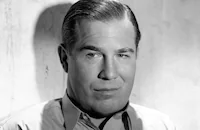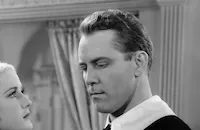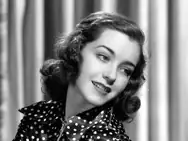Flight Command

Brief Synopsis
Cast & Crew
Frank Borzage
Robert Taylor
Ruth Hussey
Walter Pidgeon
Paul Kelly
Shepperd Strudwick
Film Details
Technical Specs

Synopsis
Navy "Hell Cat" squadron commander Bill Gary is happy that his wife Lorna is strong and doesn't breakdown after the death of one of the Hell Cats. Lorna, however, confides in her brother, Jerry Banning, who is also a Hellcat, that she is worried about Bill. The new squad recruit, Ensign Alan Drake, a recent graduate of Pensacola who is elated with his new assignment, flies hurriedly to San Diego and is forced to abandon his plane in a dense fog. He safely parachutes into the water and goes to a house, which happens to be Bill's, and is greeted by Lorna, who is amused to pretend that she only vaguely knows about the squad. When Bill meets Drake at the base, Bill laces into Drake for not following orders about jetisoning the plane sooner, but tells him that there isn't a man in the fleet who could have done better. As maneuvers and training advance, Drake, who is named "Pensacola" by the men, becomes estranged from them because of his cockiness. At first, only Jerry befriends him, but after a social gathering at Bill and Lorna's house, during which Pensacola finally discovers Lorna's real identity, Pensacola becomes part of the team, and soon begins to help Jerry with an anti-fog device. When Jerry thinks it is perfected, he decides to test it in a dense fog himself, despite Pensacola's concerns. Everything works well until the landing, when the instrument suddenly fails, causing Jerry to crash. On his way to the hospital, Jerry tells Pensacola that there was something wrong with the direction needle, then offers the device to him to perfect. At the hospital, Bill gives little solace to Lorna, thinking she is strong enough to take it, but Pensacola comforts her. Ten days later, just after Pensacola has perfected the device, some of the men ask him to visit Lorna because she is very depressed and Bill was called away just after Jerry's death. Lorna is touched by Pensacola's kindness and similarity to Jerry, and they start to spend time together. One night, as they are dining at an out-of-the-way restaurant, one of the Hell Cats, Dusty Rhodes, sees them together and suspects the worst. When they run into some of the other Hell Cats, Lorna suddenly feels ashamed of her attraction to Pensacola. Later she thanks him for his kindness, but inexplicably says that they should not see each other again. The next day, when Bill returns, she tells him that she is not the courageous woman he thinks and is leaving him to think things over. Though Bill is devastated, he doesn't tell her, and only confides in Dusty, who thinks that Pensacola is to blame. The men then confront Pensacola and ask him to leave. Despite his innocence, Pensacola doesn't want to stay with a squad that would suspect him of breaking up a marriage, and give his resignation without explanation to Bill, who asks him to stay through their upcoming maneuvers. Immediately after maneuvers end, the squad is sent on a rescue mission for a downed aircraft. Bill's plane gets an oil leak, forcing him to break formation, and despite Bills orders, Pensacola follows. When Bill crash-lands on a beach, Pensacola goes after him and takes the injured Bill on his own plane. Because of a dense fog, Pensacola must use Jerry's device to land, and is successfully able to guide the other planes as well. After they land, Dusty sends Lorna a telegram telling her that Bill is critically injured, and when she sees Bill in the hospital, they reconcile. After Lorna tells Dusty the truth about Pensacola, Dusty apologizes and asks Pensacola to stay because he is a true Hell Cat.

Director

Frank Borzage
Cast

Robert Taylor

Ruth Hussey

Walter Pidgeon

Paul Kelly

Shepperd Strudwick

Red Skelton

Nat Pendleton

Dick Purcell
William Tannen
William Stelling
Stanley Smith

Addison Richards

Donald Douglas
Pat Flaherty
Forbes Murray

Marsha Hunt
Lee Tung-foo

John Hamilton
Gaylord Pendleton

James Millican
John Sheehan
Otto Han

Irving Bacon
Albert Morin
Claire Owen
Reed Hadley
George Offerman Jr.
Dick Wessel
James Seay

Walter Sande
Gayne Whitman
John Raitt
Ed Smith
Cliff Danielson
Howard Wilson
Hal Le Seur
Gilbert Wilson
Jack Luden
Bob Davis
Crew
Frank Borzage
Lew Borzage
Cedric Gibbons
Arnold Gillespie
Commander Harvey Haislip
Commander Harvey Haislip
Robert J. Kern
Urie Mccleary
Lieut. Comdr, U. S. N. J. C. Mcelduff
Wells Root
Harold Rosson
J. Walter Ruben
Comdr. Morton Seligman U. S. N.
Douglas Shearer
Gile Steele
John Sutherland
Dolly Tree
Franz Waxman
Edwin B. Willis

Photo Collections
Videos
Movie Clip



Trailer
Hosted Intro
Film Details
Technical Specs

Award Nominations
Best Special Effects
Articles
Flight Command (1940) - Flight Command
Flight Command also introduced its star, Robert Taylor, to a favorite new hobby. A biography of the actor's wife, [Barbara] Stanwyck by Axel Madsen, noted that "for his navy ensign role Bob decided to take flying lessons. He found soaring into the air from Burbank airport liberating and exhilarating and soon began spending every spare moment at airstrips with instructors, flyers, and "hangar jocks," as general aviation enthusiasts were called." This was particularly distressing to Stanwyck who hated to fly. Taylor's interest in this new pastime got so obsessive that, at one point, his MGM bosses encouraged him to see the studio psychiatrist. Taylor refused to give up flying, though, and when the US entered World War II, he joined the United States Navy Air Corps despite major resistance from MGM mogul Louis B. Mayer who feared for his star's safety. Taylor ended up serving as a flying instructor for the Navy for the reminder of the war.
Flight Command was shot on location at a major Navy base in San Diego, California, with the full cooperation of the Navy's Air Corps, which would become standard practice for all branches of the service in the production of World War II movies. A. Arnold Gillespie (photography) and Douglas Shearer (sound) received an Academy Award nomination for the special effects used to create the movie's exciting flying sequences. A master of the craft, Gillespie created the effects for 160 films in his long career, including the justly celebrated earthquake sequence in San Francisco (1936) as well as Hitchcock's North by Northwest (1959). That same year he won an Oscar® for his work on Ben-Hur (1959), and in 1964 he and Shearer received a technical achievement award from the Academy for engineering an improved Background Process Projection System. Principal cinematography on Flight Command, however, was handled by cinematographer Harold Rosson, who lensed such MGM classics as The Wizard of Oz (1939), On the Town (1949), and Singin' in the Rain (1952). Although closely associated with top musicals, Rosson also earned his action/war credits with his work on Thirty Seconds Over Tokyo (1944), the film that earned Gillespie his first Oscar® for special effects.
Also proving himself here in a new arena was director Frank Borzage, who at this time had been one of Hollywood's most successful directors for more than a decade. Borzage is best known for complex and compelling 1930s romances, what critic Andrew Sarris has called "a genuine concern with the wondrous inner life of lovers in the midst of adversity." Borzage's other film released the same year, The Mortal Storm (1940), one of three movies he made with actress Margaret Sullavan, was one of the most chilling portraits of the horrors of Nazism. Although couched in a sensitive love story, the film likely also contributed to turning the tide of public opinion toward a willingness to fight the rise of fascism in Europe. Ironically, Flight Command, done in the more "realistic" patriotic action style that would dominate American screens for the next several years, marked the decline in his career. Such finely-wrought, tender romances as Seventh Heaven (1927), which earned him the first Best Director Award ever given by the Academy, A Farewell to Arms (1932), and Desire (1936), a wry romantic comedy about jewel thieves Gary Cooper and Marlene Dietrich, had fallen out of favor by 1940, and Borzage's work has become largely neglected.
Red Skelton appears in a small role in Flight Command, his third movie. He would shortly become one of MGM's top comic stars of the decade.
Director: Frank Borzage
Producers: Frank Borzage, J. Walter Ruben
Screenplay: Wells Root and Commander Harvey Haislip, based on a story by Haislip and John Sutherland
Cinematography: Harold Rosson
Editing: Robert J. Kern
Art Direction: Cedric Gibbons
Original Music: Franz Waxman
Cast: Robert Taylor (Ensign Alan Drake), Ruth Hussey (Lorna Gary), Walter Pidgeon (Commander Bill Gary), Paul Kelly (Lt. Commander "Dusty" Rhodes), Red Skelton (Lt. "Mugger" Martin).
BW-116m. Closed captioning.
by Rob Nixon

Flight Command (1940) - Flight Command
Quotes
Trivia
Notes
According to news items in Hollywood Reporter, an early working title of the film was Hell Cats. The opening credits have the following acknowledgment: "With the gratefully acknowledged cooperation of the United States Navy." A pre-production news item lists Walter Strohm as the assistant director, however, only Lew Borzage is listed after the film began production. Another news item, on August 7, 1940, noted that R. C. Sheriff was "polishing" the script, however, he is not mentioned elsewhere and his contribution to the film has not been determined. According to the pressbook for the film contained in the AMPAS Library, the picture was made by M-G-M at the federal government's request to increase the public's awareness of the importance of defense preparations. The world premiere in Washington, D. C. coincided with celebrations for "Pan American Aviation Day." A Hollywood Reporter news item on December 17, 1940, noted that the picture was previewed aboard an airplane flight from Washington to Pittsburgh on 15 Dec. Modern sources credit Richard Rosson and Elmer Dyer with 2nd unit direction and include Paul Mantz and Frank Clarke on the 2nd unit camera crew which worked on various flying sequences.
















